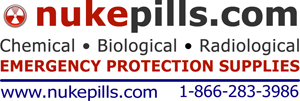Nuclear Bombs vs Dirty Bombs vs Suitcase Bombs vs EMP Bombs
During the Cold War in the 1950s and early 1960s, the U.S. government conducted about one hundred nuclear weapons (atomic bomb) tests in the atmosphere at a test site in Nevada. The radioactive substances released by these tests are known as “fallout.” They were carried thousands of miles away from the test site by winds. As a result, people living in the United States at the time of the testing were exposed to varying levels of radiation.
Among the numerous radioactive substances released in fallout, there has been a great deal of concern about and study of one radioactive form of iodine (called iodine-131, or I-131) which collects in the thyroid gland. People exposed to radioactive iodine I-131, especially during childhood, may have an increased risk of thyroid disease, including thyroid cancer. One particular personal radiation detector has the technology to detect both the beta and gamma radiation of radioactive iodine I-131.
According to the National Cancer Institute’s 1999 report “Exposure of the American People to Iodine-131 from Nevada Nuclear-Bomb Tests” exposure to radioactive iodine I-131 from the tests will produce between 11,300 and 212,000 excess lifetime cases of thyroid cancer with a point or central estimate of 49,000 cases. The online I-131 Dose/Risk Calculator, courtesy of the National Cancer Institute, can tell you with 90% accuracy your exposure to cancer-causing radioactive iodine I-131. It would have been nice had the U.S. Gov had some potassium iodide available back then for yours truly. My chances of getting thyroid cancer, according to this calculator, is 1.6 in 1000. Low odds – but why take chances.
Radioactive Iodine (I-131) exposure from nuclear bombs
Radioactive Iodine is a byproduct of nuclear fission processes in nuclear reactors and nuclear weapons such as atomic bombs and suitcase bombs. You can protect yourself from the effects of cancer-causing radioactive iodine with FDA Approved IOSAT™. A non-prescription drug, Potassium Iodide protects against radioactive iodine by preventing its absorption by the thyroid gland located in the neck. The U.S. government has a limited supply in case of a nuclear bomb detonation or nuclear reactor accident/attack, yet Potassium Iodide must be taken during or before exposure to radioactive iodine to be effective. View our Potassium Iodide page for more information including F.A.Q.s.
Exposure of American People to I-131 (Radioactive Iodine) from Nevada Nuclear Bomb Tests in the 1950s and 1960s
Suitcase Bombs
In 1997, the public became aware of a Russian nuclear device they had not known even existed–the “suitcase bomb”. One of these portable nuclear bombs had an explosive charge of one kiloton, equivalent to one thousand tons of TNT. If a device like this made its way to the U.S. it could destroy everything within a half-mile radius of the Capitol in Washington, D.C. Within hours, prevailing winds would carry the nuclear fallout throughout Washington. Radioactive Iodine (I-131) would be carried downwind for miles. One particular personal radiation detector has the technology to detect both the beta and gamma radiation of I-131.
Another portable weapon is a “backpack” bomb. The Soviet nuclear backpack system was made in the 1960s for use against NATO targets in time of war and consists of three “coffee can-sized” aluminum canisters in a bag. All three must be connected to make a single unit in order to explode. The detonator is about 6 inches long. It has a 3-to-5 kiloton yield, depending on the efficiency of the explosion. It’s kept powered during storage by a battery line connected to the canisters.
Dirty Bombs
A “dirty bomb” is a conventional explosive, such as dynamite, salted with radioactive waste that scatters when the bomb goes off. It is not a nuclear bomb. The bomb can kill or injure through the initial blast of the conventional explosive and through the dispersal of the radioactive materials– hence the term “dirty.” Such bombs could be small devices or as big as a truck bomb.
There are four categories of radioactive waste ranging from very low-level waste that can be safely disposed of with ordinary refuse, to high-level waste such as spent nuclear fuel. Substantial amounts of radioactive waste are generated through civilian and military applications of radionuclides in medical facilities, food irradiation plants, chemical and manufacturing plants, etc. Some types of radioactive waste would be easier to obtain than others in order to make a “dirty bomb”.
Radiation detectors are needed to alert officials of their presence. One particular personal radiation detector has the technology to detect Gamma, X-ray and Beta radiation. This includes the ability to detect radioactive iodine, of which Potassium Iodide protects against and would most likely not be present in a dirty bomb due to the fact that it is a byproduct of nuclear fission which takes place only within nuclear reactors and during the detonation of a nuclear bomb. Obviously this type of ‘radioactive waste’ would be very difficult to obtain and incorporate in the makings of a dirty bomb.
If a dirty bomb detonates in your area, follow the instructions of local health officials concerning evacuation, decontamination and the administering of potassium iodide (though unlikely). Nukepills.com offers the Dirty Bomb Emergency Kit™ for detection and decontamination of radiation likely found in a dirty bomb.
Federal Government statements on Dirty Bomb radiation
- Beta and Gamma Radiation: “…cesium-137 is of particular concern because it is a potential component of a conventional explosive device (a “dirty bomb”) containing radioactive material.” – FDA “Dirty Bomb” treatment document
- Gamma Radiation: “Thallium-201 has also been mentioned as a potential component of a dirty bomb.” – FDA Dept of Health and Human Services (PDF file)
- “A variety of radioactive materials are commonly available and could be used in an RDD [Radiological Dispersal Device, a.k.a. Dirty Bomb], including Cesium-137, Strontium-90, and Cobalt-60.” – CIA report: Terrorist CBRN: Materials and Effects
- NRC Dirty Bomb Fact Sheet
EMP (Electromagnetic Pulse) Bombs
An electromagnetic pulse EMP is a byproduct of detonating an atomic bomb above the Earth’s atmosphere. When a nuclear weapon is detonated in space, the gamma rays emitted trigger a massive electrical disturbance in the upper atmosphere. Moving at the speed of light, this overload will short out all electrical equipment, power grids and delicate electronics on the Earth’s surface. In fact, it would take only one to three weapons exploding above the continental United States to wipe out our entire grid and transportation network. It might take years to recover from, if ever.
RADTriage™ Radiation Detector is impervious to an EMP bomb. The RADTriage™ Radiation Detector will continue to work after an EMP bomb detonation because it has no electronics.


